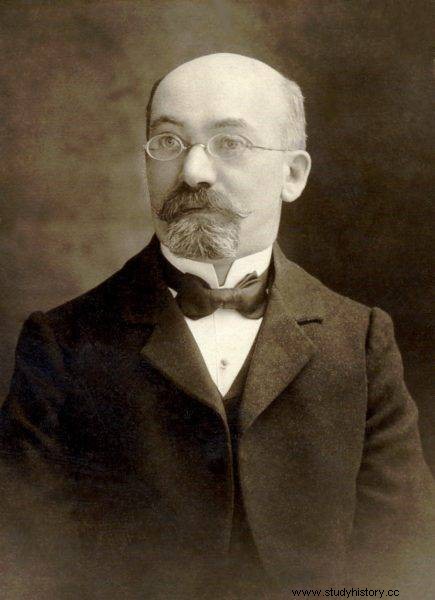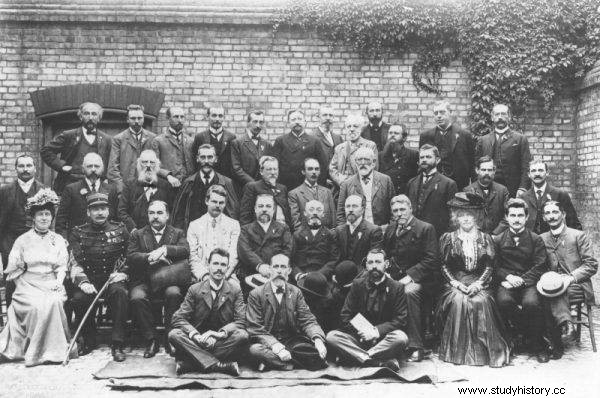Raised in a multicultural environment, Ludwik Zamenhof, a Pole, believed that a common language known to all people could help bring peace to the world. With this in mind, he created his Lingwe Universal, which in theory was neutral and easy to learn, meant to be a bridge between nations. Indeed, the language has up to 1.5 million speakers today, although it has gone down in history under a slightly different name - Esperanto.
Most people associate Esperanto only with an artificially created language. In a way rightly so, but it does not reflect the phenomenon it really is. Meanwhile, his followers consider him to be more than just a collection of words. Moreover, while Esperanto is widely believed to be a marginal language and not very important to the world arena, it is in fact used by a large number of people. The problem is that the lion's share of the user numbers and community documentation is not known to "outside" observers because ... it is written in Esperanto!
Linguists dealing with "invented language" most often believe that while it is a scientific curiosity in itself, its true face and meaning becomes apparent only after learning about the ideology behind it. What? Well, as is usually the case with ideology, again - "outsiders" have a slightly distorted picture of the situation ...
Science, trade and… socialism
“When the League of Nations was founded, people believed that a common world language was needed. UEA operated in Geneva under the leadership of Edmund Privat (1889–1962). Others believed that the language of Zamenhof would become the language of socialism that had begun to spread in Europe . Still others found Esperanto useful for science and commerce. Soros' friend Mark Starr, after emigrating to America and as a representative of trade unions, recommended Esperanto as the world language of the labor movement. Soros, Kalocsay and Baghy founded the Privat cabaret [...] "wrote Humphrey Tonkin in the afterword to Tivadar Soros' book" Masquerade around death. "
The father of the famous billionaire, George Soros, was fluent in Esperanto and it was in this language that he decided to write down a dramatic account of his and his family's experiences during the last year of the war in Hungary, when the Germans began the mass extermination of local Jews.

The creator of Esperanto was a Pole, Ludwik Zamenhof.
This moving testimony of inhuman times was recently published in Polish by the Novae Res publishing house. It was translated by Emilia Ewa Siurawska, an outstanding Polish expert in Esperanto. Fascinated by reading the memoirs of Tivadar Soros, she wanted Polish readers to learn about the fate of this colorful figure. Unfortunately, she died in 2017, so it was not possible to make any corrections to the translation. Hence, the text may sound a bit archaic in some places.
Esperanto itself, although it was created over 130 years ago, is by no means archaic. Interestingly, its initiator was a Pole, Ludwik Zamenhof. What was his real purpose when he was working on a common speech for all people?
The man who wanted to destroy the Tower of Babel
Born in 1859 in Białystok, as one of the eleven children of the Zamenhofs, he wrote the drama "The Tower of Babel, or a Bialystok tragedy in five acts" at the age of ten. Ludwik was of the opinion that all misunderstandings and interpersonal conflicts result from the language barrier. It is very likely that he observed the effects of this barrier in vivo in the cultural cauldron of the Białystok community, composed of Jews, Poles, Russians and Germans. It is also possible that it was thanks to growing up in such an environment that the young Jew had the opportunity to polish his language skills.
Despite his deep fascination with linguistics, Zamenhof undertook medical studies. He studied in Moscow, but returned to Warsaw after the assassination of Tsar Alexander in 1881. In 1886 he completed his ophthalmology specialization in Vienna. He was constantly tormented by the issue of disagreement, so much so that while still in junior high he began to work on his own language, which at that time was called "Lingwe Universal". The project evolved, it was rewritten three times, and finally in 1885 the final version known to this day was created.
The first textbook "International Language. Preface and complete manual ”Zamenhof wrote in Russian. He published it under a pseudonym - as "Doctor Esperanto", meaning "Doctor Hoping". Hence the current name of the language.
Soon Esperanto began to gain a group of supporters praising Zamenhof's design for its simplicity and full range of possibilities. The first Esperantist clubs appeared, and in 1905 a congress was held in the French city of Boulogne-sur-Mer.
In 1913, Ludwik Zamenhof was nominated for the Nobel Peace Prize. For the first time, in total, his candidacy was put forward 14 times, including the last time in 1917. In the same year, on April 14, Doctor Esperanto died. He was buried at the Jewish cemetery on Okopowa Street in Warsaw.
A language with vision
"Zamenhof's idea was to make a neutral, easy as second, auxiliary language enable communication between people of different nationalities" - we read in "Masquerade around death". Although it was created as an artificial creation, over the following decades it underwent phonetic, morphological and many other changes that were natural for every communication tool.
At the same time, the Esperanto-speaking community has evolved. It is estimated that is currently used by approximately 1.5 million people, some of whom use it on a daily basis at home . There are many organizations around the ideology initiated by Zamenhof, ranging from the International Catholic Union of Esperantists issuing the newspaper Espero Katolika (from 1903 until today!).

Lingva Komitato (Language Committee), predecessor of the Akademio de Esperanto in 1907.
Like other minorities, Esperantists also fell victim to persecution - in Nazi Germany and the Soviet Union, for example. Nevertheless, both after the First and Second World Wars Esperanto speakers had hoped for this language to ensure better communication, and thus global peace . Efforts were made to recognize it as a world language. Over 80 million people signed the petition to the United Nations. In 1987, support for Esperanto was also expressed by the authorities of the Polish Academy of Sciences, and in 1990 the Holy See granted permission to conduct Mass in Esperanto without additional permits.
Unfortunately, despite these efforts, Esperanto remains in the shadows. Why? Perhaps a major role is played by the technological and cultural dominance of the English language.
Bibliography:
- Forster, P., The Esperanto Movement. Mouton Publishers, New York, 1944.
- Soros, T., Masquerade around death . Novae Res, Gdynia, 2021.
- Żelazny, W., Ludwik Zamenhof. Life and work. Reception and reminiscences. Selection of letters and letters . Nomos, Krakow, 2012.
